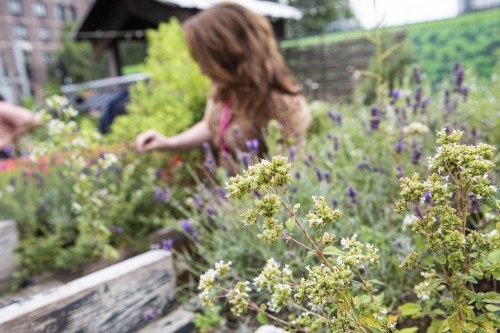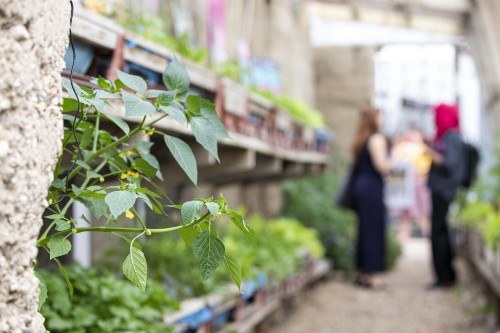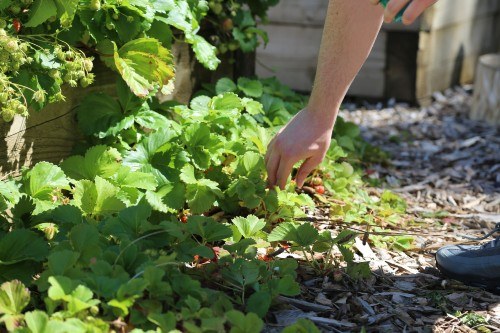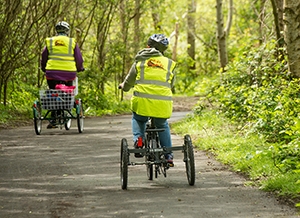
Engaging people in climate action
Climate change can feel so huge and overwhelming that people may think local action isn’t enough to make a difference. But there’s lots that individuals and communities can do, and much to be gained – and not just in reducing carbon emissions or increasing biodiversity. Taking action with your neighbours helps build community and strengthen local pride and can also deliver a host of health and wellbeing benefits.
Here we’ve captured lessons from our grant holders who have successfully mobilised their community to take action, maximised engagement and motivated locals to live and work more sustainably.
Listen to this article
You can listen to this article as a sound recording, lasting 20 minutes and 23 seconds, by clicking the button below.
1. Make it easy
If climate action feels like hard work or a thankless task, people are less likely to get or stay involved. Make things easy for them, right from the start.
- Break things down into clear, concrete, achievable steps. For example, give advice on what, how and where different materials can be recycled locally, especially if it’s something not taken away as standard with household rubbish collections. In Edinburgh, Networking Key Services (NKS) and Edinburgh Lothian Regional Equality Council (ELREC) offer targeted support and capacity building for ethnic minority communities. Advice is tailored to people’s work and lives, such as waste management workshops for catering staff in Asian restaurants, help with edible gardening and composting, and a trip to a local recycling centre as part of work on how to tackle different kinds of waste.
- Remove practical barriers. If you want to encourage litter picking, provide free grabbers and bags. Tamworth Volunteer Litter Pickers supply litter kits, including stickers for bags so that council bin staff don’t mistake litter collections for dumped household waste.
- Encourage borrowing rather than buying. Tool, uniform and toy libraries are a positive way to help people reduce waste. Totnes Share Shed’s most borrowed items include things we all need from time to time, like power drills, strimmers and carpet cleaners. When bought new these are typically only used for a few minutes of their lifetime. Borrowing not only increases how often tools are used, but also reduces unnecessary purchase and saves people money. In two years over 1,700 people used the Totnes mobile share service, avoiding up to 3,200 purchases that would have cost members over £200,000.
- Help people gain new skills to repair, adapt and reuse material that would otherwise go to landfill. For example, workshops about upcycling old furniture can encourage more people to hang on to something or buy second-hand. Textile repair workshops enable families to turn unwanted or ripped clothes into something beloved and beautiful, again reducing waste.
- Start with the people who are most willing and motivated, as they may just need a nudge to do more. Converting sceptics will inevitably take longer, but it’s easier when you have a group of people to help and a track record of making positive change happen.
- Share practical ideas about what’s happening in your neighbourhood. Using local examples makes it easier for people to see how they could get involved. It also encourages a sense of community and can build resilience: people are more likely to keep going when they feel a positive connection with their neighbours.
Small changes, big difference
Reducing your carbon footprint is easier once you have practical know how. Groundwork’s Green Doctors provide simple tips to reduce energy consumption at home. As well as giving free one-to-one advice, their short videos give practical help, explaining how to adjust hot water temperature, install draft proofing, and set up storage heaters.
The project has supported over 60,000 households to reduce their energy use and save an estimated total of £5 million annually on energy bills.
Reducing energy use
In Wales, the Hwb Torfaen replaced over 40 light fittings, replacing them with lower-energy LED. The annual saving is estimated to be £2,019 and 5.1 tonnes of CO2.
This simple improvement has led to changed behaviour. Because the new lights are much brighter, users don’t turn them all on. It’s helped to create a new mindset: “We now have an environmental policy, we have two young people who are now ‘climate champions’ and becoming carbon neutral is at the forefront of our minds, this grant has changed the culture of our organisation.”
2. Get the timing right
People are more receptive to changing their behaviour or taking action at certain times in their lives, or in response to changes in society.
- People are more likely to change their behaviour and habits during times of transition, such as moving home or during wider policy and strategy change. So these changes are an opportunity to embed more environmentally-friendly ways of working and living. When the 2021 UN climate change conference COP26 was held in Glasgow, Climate Action Fife organised Fife-wide mass participation events and campaigns to tie in with the conference. These included the “Big Five for Fife” campaign, in which people pledged to make achievable everyday changes, with advice and support on how to make them last. The group estimates that the Big Five pledges and its climate engagement plan led to savings of 76 tonnes of carbon dioxide equivalent, with a lifetime saving of 228 tonnes.
- Instant feedback can be effective in galvanising people to take action. In Wiltshire, Great Green Bedwyn used infrared heat cameras to show people the heat being lost from their homes. 15 people went on to improve their insulation and draughtproofing, and some fitted a heat pump. And we’ve seen that people react to smaller interventions, such as home energy monitors: seeing the reading shoot up when you put the kettle on encourages you to be more careful about over-filling or boiling it so frequently.
- Emphasise the link between environmental work and things people already care about. Irwell Valley Sustainable Communities helped Salford residents to flood-proof their homes in response to the flooding of the River Irwell. This inspired further sustainability projects, including community gardens, wetland creation, and carbon literacy education.
3. Make it appealing

Changing behaviour requires effort, so it helps if you make it attractive. If you present climate action as an appealing choice, people are more likely to take part. There are simple ways to do this:
- Accentuate the positive. Presenting the benefits of a sustainable, green society can be more effective than negative wording about sacrifices and responsibility. That doesn’t mean you shouldn't encourage people to make different choices – but it helps to emphasise the personal, societal and environmental benefits, to help offset any inconvenience.
- Emphasise the money to be saved. Cutting costs is motivating and doesn’t have to be hard. Energy bills can be reduced by turning the thermostat down one degree, water bills by fitting simple water saving devices, and fuel costs by cycling, walking or using public transport. In Wales, 303 working families have saved an average of £426 per family per year just by using tool/toy/uniform libraries, doing home improvements by themselves, and picking up practical money saving tips from others in the community.
- Rewards and recognition. When you recognise people’s efforts, it can motivate them to do more. Try small prizes for the most active litter pickers, or awards for people or businesses achieving the greatest reductions in energy use. Local press stories highlighting inspiring examples help too.
- But be careful with short-term incentives. One-time rewards can be a good start, but evidence suggests that the new behaviour stops when the incentive is no longer there. Longer-term rewards like lowering energy bills permanently, making new friends, or learning new skills can be more effective at supporting lasting behaviour change.
4. Recognise people’s desire to connect and belong

Framing action as something you can do together, can be very motivating, with the added benefit that people don’t want to let their friends or neighbours down.
- Emphasise the wellbeing benefits of taking action. The 2 Minute Foundation encourages people to spend just two minutes picking up litter. By making it simple to act they’ve mobilised over 80,000 residents, with many saying that taking part has strengthened their personal sense of purpose, hope and optimism. For some, this simple, discrete action has helped make them feel more connected to their community and less isolated or alone.
- Role-modelling can be effective. Green champions can demonstrate involvement on the ground, while external experts can offer tailored advice. Remember that personality makes a big difference when you’re trying to energise and motivate others. Whether you’re appointing someone from within the community, or looking for an outside consultant, it’s important to match the person to the role.
- People like face-to-face contact, and help getting over any initial hurdles. For example, people are happy to use technology that can save energy and save money, but are often put off by the upfront costs of equipment and setup. Leeds Handyman helps older people and vulnerable adults with fuel efficiency, by assessing homes and installing suitable equipment, such as wireless thermostats and smart switches.
- Senior buy-in helps motivate others. If an organisation’s leadership is visibly invested in climate action, it encourages everybody else to join in. At the Fund, we’ve set targets designed to help us reach operational net zero by 2030. All directorates commit to environmental actions in their business plans, and 68 colleagues have received training in carbon literacy. We encourage staff to make public transport their first choice for work travel. Flights within Great Britain (except to or from Scottish islands) are permitted only as exceptions, cutting CO2 emissions by 82% between 2019/20 and 2022/23. In the same period, we’ve cut emissions for travel and overnight accommodation by half, and reduced waste to landfill by 85%.
5. Acknowledge and share the co-benefits

A lot of climate action has additional benefits for individuals and communities, these are often referred to as co-benefits. By emphasising these, you may engage people who might be less easily motivated by the environmental benefits alone.
- Showcase all the positives. A community allotment may have many environmental benefits – but it can also be promoted as an opportunity to meet new people, learn gardening skills, and improve health and wellbeing. Y Fasged Siopa, which collects and distributes surplus food, is giving people who need it healthy, good quality ingredients, saving families an average £912 a year on household costs and diverting an estimated 18 tonnes of food from landfill each year.
- Calculating and sharing financial benefits can help to influence leaders from businesses and community groups. When energy prices soared during the 2022/23 cost of living crisis, many organisations looked to green energy to help future-proof their premises against rising bills. In Carrickfergus, CWA Brass Band installed solar panels on its community hall, cutting its energy consumption and making the venue more attractive to other groups to use. The Band is also using the panels to promote climate awareness, including a solar power information night with food and a lecture, and work with local schools’ eco clubs.
6. Be inclusive
People want to see others like them as part of a movement, and to see that others recognise and want to tackle the specific concerns of their community.
- Take active steps to engage a diverse group of people. Practical adjustments like recruiting community representatives into paid roles – and paying the living wage, targeting outreach work with communities you are not reaching and ensuring that both indoor and outdoor venues are accessible to people with disabilities are important ways to make environmental projects more inclusive.
- Involve people from diverse backgrounds in decision-making. Co-production techniques and having visibly diverse leadership can help make activities attractive and relevant to a wider range of people.
- Profile and platform the work that is already happening. This includes tackling the widespread assumption that environmental action is disproportionately white and middle class. Our report on co-production explains the benefits of bringing together people and stakeholders to create and deliver services.
Telling the story of change: make it tangible for your audience
London’s Forest Recycling Project saves leftover paint from landfill, reselling it at a low cost. It provides free reclaimed paint to new housing association residents, helping them save money on redecorating costs and reducing waste. The project takes care to reassure customers that this approach doesn’t mean compromising on quality.
By reducing the demand for new paint, the project is estimated to have saved almost 1.5 million kg of CO2 emissions.
Recognising and supporting the work that’s already happening
In Bristol, the Black and Green Ambassadors mentor climate action leaders from Black, African, Caribbean, Asian and other minority ethnic backgrounds.
Ambassador Asia Yousif organised a workshop for people from Sudan, Pakistan, Somalia, India, Eritrea and Sri Lanka to pick and cook with organic vegetables and discuss sustainability. She found that many cultural practices are already sustainable, without people recognising them as such.
The project has created opportunities for diverse voices to become a greater part of climate action. Black and Green Ambassadors were invited to speak at the 2021 UN climate change conference COP26. “It’s got us in the room with policy makers,” explains ambassador Roy Kareem, on speaking with the Mayor of Bristol, at Bristol’s Climate Citizens Assembly, and London Climate Action Week.
Read the Black and Green year one report and Next Generation report for more information about their work.
7. Show the difference you’re making

Quick wins, visible change and recognition of what people have achieved are good motivators because they are tangible and concrete, and tell a positive and uplifting story of change.
- Seeing change in community spaces, or other local people taking an active role, can be inspiring. It demonstrates that people like you can make a difference. Public improvements such as community gardens, allotments and cycling and walking paths will always reach wider audiences. Manchester Climate Change Agency organised urban greening activities in the busy Northern Quarter of the city, including street planters and a gardening takeover day on the top floor of a multi-storey carpark. And the group engaged Manchester City and United football fans in three weeks of sustainable food challenges. Three months on from the challenge, 70% of participants eat less meat, 83% waste less food, and the average participant is saving £17.47 on their weekly shop.
- Environmental improvements are sometimes intangible: find ways to make them concrete. In Bristol, Bristol Green Capital Partnership has used Community Carbon Footprints to show what activities are responsible for emissions, and how much carbon they generate. The data is organised under housing, transport, food and diet, goods and services, and waste management. So community groups can see where change is most needed, and what effective action can be taken at individual or community level.
- Avoid jargon and use language that everyone can understand. Our Climate Action Fund jargon buster helps unpack commonly used terms, and with support from the Media Trust, we have put together a comprehensive toolkit to help communicate about climate action effectively.
8. Keep up the energy
Time-limited projects and enthusiastic individuals can be great at driving engagement. But what happens when the funding ends, or the person moves on? Think about how you’ll keep momentum going over time.
- Give your networks a sense of ownership to make them stronger and more lasting. Greening projects – which find ways to add plants to an urban neighbourhood, such as window boxes or vertical planting – could ask volunteers to help with planting and watering. This encourages community pride, while addressing the need for ongoing maintenance.
- Find fun ways to measure progress – it will sustain energy and interest. It’s motivating to see what you’ve achieved, particularly if it’s done in an engaging way. Footprints Women’s Centre installed solar panels, energy efficient light bulbs, cavity wall insulation, and movement sensors for lighting to reduce its carbon footprint. The Centre then installed a battery energy storage system, to store excess energy from solar panels, with a digital screen – which shows the energy being generated, and the money and CO2 being saved. The screen is on display in the Centre’s foyer, where it’s become a big topic of conversation for everyone who comes in: staff use it to raise awareness and advocate for sustainability with visitors.
- Use healthy competition to encourage and reinforce change. You could encourage people to track how much waste goes to landfill in seven days, then see if they can do better next week.
- Set targets to keep up momentum, share your aims and have fun. You could have a league table of green action, to see where you’re doing most good, and where you might do better. Get the community involved in gardening events, and see who can finish their window box or planter first. It’s a way to make the process faster, and to get people invested in the results.
Want to find out more or share your story?
For more detail about how our charities and communities have engaged people in climate action, read our report Community Action for the Environment. And explore our other top tips on making an environmental action plan and reducing the carbon footprint of community events.
If you’ve had success in motivating residents in your community, please do consider sharing your tips and experiences with us at knowledge@tnlcommunityfund.org.uk.